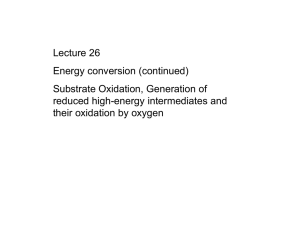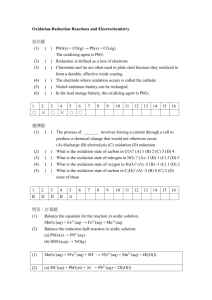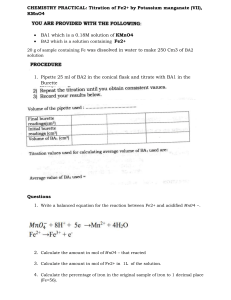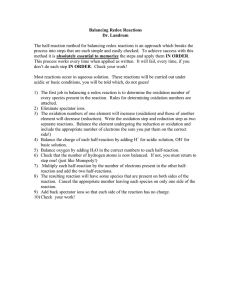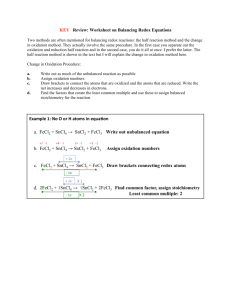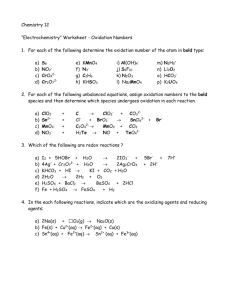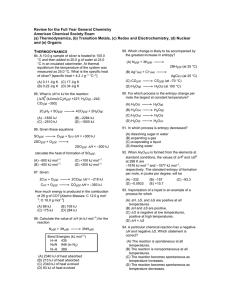Answers Test 4 Chapters 19 and 20 Silberberg
advertisement
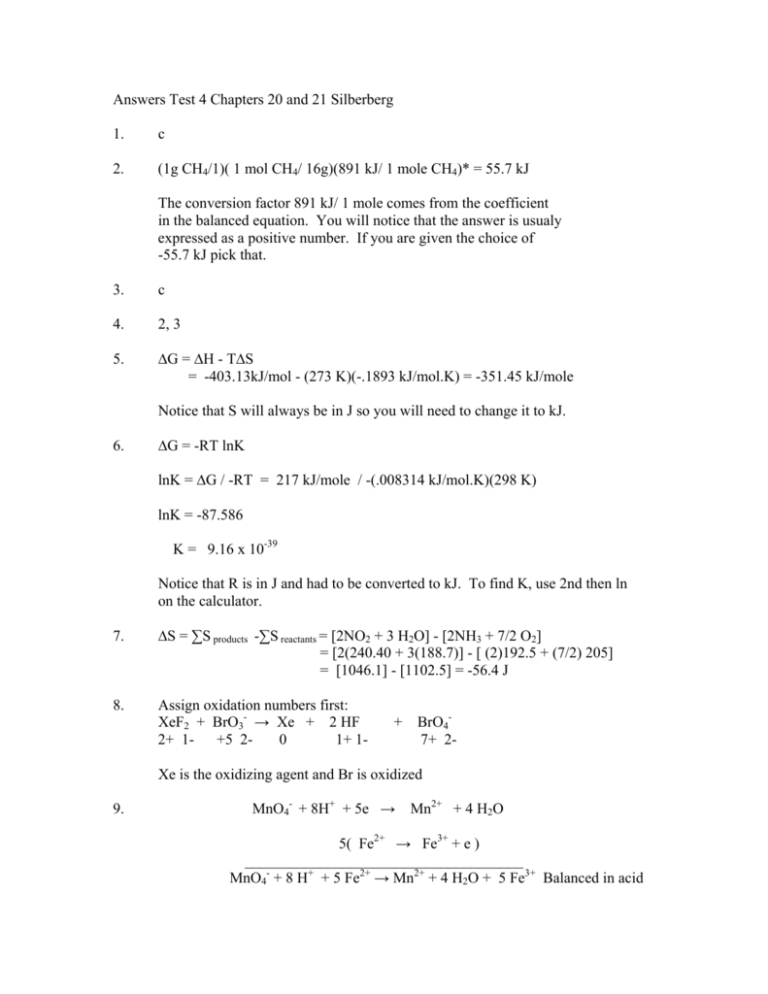
Answers Test 4 Chapters 20 and 21 Silberberg 1. c 2. (1g CH4/1)( 1 mol CH4/ 16g)(891 kJ/ 1 mole CH4)* = 55.7 kJ The conversion factor 891 kJ/ 1 mole comes from the coefficient in the balanced equation. You will notice that the answer is usualy expressed as a positive number. If you are given the choice of -55.7 kJ pick that. 3. c 4. 2, 3 5. ∆G = ∆H - T∆S = -403.13kJ/mol - (273 K)(-.1893 kJ/mol.K) = -351.45 kJ/mole Notice that S will always be in J so you will need to change it to kJ. 6. ∆G = -RT lnK lnK = ∆G / -RT = 217 kJ/mole / -(.008314 kJ/mol.K)(298 K) lnK = -87.586 K = 9.16 x 10-39 Notice that R is in J and had to be converted to kJ. To find K, use 2nd then ln on the calculator. 7. ∆S = ∑S products -∑S reactants = [2NO2 + 3 H2O] - [2NH3 + 7/2 O2] = [2(240.40 + 3(188.7)] - [ (2)192.5 + (7/2) 205] = [1046.1] - [1102.5] = -56.4 J 8. Assign oxidation numbers first: XeF2 + BrO3- → Xe + 2 HF 2+ 1- +5 20 1+ 1- + BrO47+ 2- Xe is the oxidizing agent and Br is oxidized 9. MnO4- + 8H+ + 5e → Mn2+ + 4 H2O 5( Fe2+ → Fe3+ + e ) _____________________________________ MnO4- + 8 H+ + 5 Fe2+ → Mn2+ + 4 H2O + 5 Fe3+ Balanced in acid In Base: 8 OH→ 8 OH_______________________________________ MnO4- + 8 H2O + 5 Fe2+ → Mn2+ + 4 H2O + 5 Fe3+ + 8 OH- Combine water MnO4- + 4 H2O + 5 Fe2+ → Mn2+ + 5 Fe3+ + 8 OH10. C 11. A 12. E cell = E oxidation + E reduction = 1.63 + -1.21 = 0.42 V Both of the equations given are reduction potentials. The more positive one (CdS) will remain reduced and the other will have to be reversed and oxidized. When oxidized, the sign is changes so the oxidation potential for Ti is 1.63. 13. E cell = E oxidation + E reduction = - .8 + .99 = .19 V if the E is positive, it is spontaneous. 14. E = Eo - .0592V/n log Q = 0.3V - .0592 V / (2) log [Fe2+] / [Sn2+] = 0.3V - .0592 V / (2) log [.5] / [.001] = 0.3 V - .08 = .22 V To get the expression for Q you must reverse the Fe2+ reaction: Sn2+ + Fe ↔ Fe2+ + Sn To get 0.3V for E use E cell = E oxidation + Ereduction 15. ∆G = - nFE = - (1) (96,500C) ( 0.5 V ) = -48250 J or - 4.8 kJ [1 V = 1 J/C] n stands for the moles of electrons transferred in the balance equation. In this eqution Mn3+ is both oxidized and reduced: Mn3+ → Mn2+ change of 1 electron Mn3+ → MnO2 change of 1 electron ( Mn in MnO2 is 4+) To determine n you can use either the oxidation half-reaction or the reduction half-reaction. 16. it = nFe (10 amps)(600 s) = n (96,500C)(2) n = .062 moles of Ni (.062 mol Ni/1)( 58.7g/mol Ni) = 3.6 g Ni 17. logK = nEo / 0.0592V = (2) (0.01 V) / 0.0592 V K = 2.17 n is 2 because: H2 → 2H+ or NO3- → NO2- is a change of 2 electrons. 18. b 19. b 20. a 21. c 22. e 23. e 24. c it = nFe (3.86 amps)(972s) = 1.52/MM(96500C)(1) MM = 39 In the equation substitute n, moles, with g/molar mass. e is 1 because all of the elements are in column I on the periodic table and it takes one electron to bring them to the zero oxidation state which is the elemental form.
